On the flip side, I'm a sucker for historical and Western romances. So it was that that was how I first came across the Anasazi in Elizabeth Lowell's books about the MacKenzie Blackthorn families set in southwest Colorado.
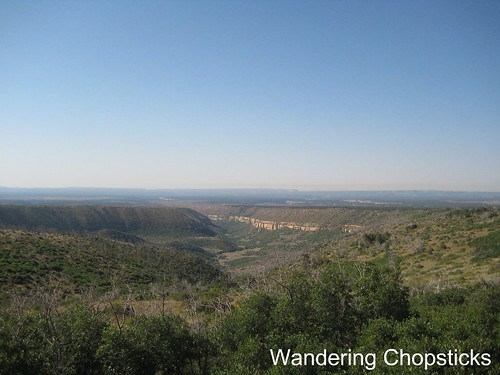
Mesa Verde, Spanish for "Green Table," because surely after wandering through the dry, dusty desert, this lush, green vista must have been quite a welcome contrast. Of course, after reading Lowell's evocative descriptions of stone ruins and an ancient people who disappeared long ago, I had to borrow the "A" volume of the encyclopedia as well as other books. And thus, Mesa Verde National Park in southwest Colorado immediately got added to the list of places I wanted to some day visit.
In "Fire and Rain" the heroine talks about searching the canyons for ancient ruins.
"I'll taste the rain winds and hear water rushing over stone, and I'll see in every shadow a culture that was old before Columbus set sail for India and found the New World." (Fire and Rain, pg. 86)The Anasazi lived in the Four Corners area since 1200 BC in a semi-nomadic existence before building pithouses around 550 AD. They didn't start building cliff dwellings until the mid-1100s, and then abandoned the area completely by the 1300s. No one really knows why, after constructing homes that were virtually inaccessible except by treacherous rock climbing, ropes, or very high ladders, the Anasazi abandoned their cliff houses and the whole area. Theories about why they disappeared ranged from migration because of prolonged drought to other environmental changes to religion to warfare. I'm sure the answer lies somewhere in between, or maybe it's a combination of all those factors.
Today they're referred to as Ancient Puebloans, but I prefer to use the name Anasazi, which in Navajo means either "Ancient Ones" or "Ancient Enemies." This is partly because I've been thinking of them that way for a long time, but also because I agree with the sentiments expressed in the Wikipedia article,
"David Roberts, in his book "In Search of the Old Ones: Exploring the Anasazi World of the Southwest", explained his reason for using the term "Anasazi" over a term using "Puebloan", noting that the latter term "derives from the language of an oppressor who treated the indigenes of the Southwest far more brutally than the Navajo ever did.""It makes less sense to me to refer to them by a Spanish term when the Anasazi were long gone, or rather had migrated and become other Southwest Native American tribes, by the time the Spanish even got to the New World.
But I digress. After grabbing a quick breakfast of Navajo fry bread from Ted's Taco - Mancos - Colorado, to eat on the road, it was just a short drive to Mesa Verde National Park. Since it was early August, in the midst of the high season, we paid $15 per vehicle. It's $10 the rest of the year. The park pass is good for a week, but we only had a day to squeeze in as much as possible.
After a 15-mile meandering and steep drive past the park entrance, we arrived at the Far View Visitor Center. Since we got there so early, the tours weren't completely booked yet so we were able to sign up for both Balcony House and Cliff Palace. Both were $3 ranger-led tours that must be booked on-site. My guidebook said during high season, sometimes the park limits visitors to only one tour. Cliff Palace, with 150 rooms and 23 kivas, is the largest of all the cliff dwellings in North America. But Balcony House features 32-foot ladders, claustrophobic 12-foot tunnels, and incredibly narrow stairs. I think I would have been devastated if I couldn't have seen both.
The tours last about an hour, and the ranger suggested booking the next tour 90 minutes after the start of the first. On the map, the two cliff dwellings looked far apart and I was afraid we'd miss Cliff Palace so I erred on the side of caution and booked it 2 hours later. We ended up with way too much time to kill. But again, I digress.
OK! OK! Let's get to the good stuff!
In front of the visitor center was a model of the Balcony House tunnel that you'd have to crawl through. If you're claustrophobic and can't handle 12 feet of the narrow space below, then I suggest not going on this tour.
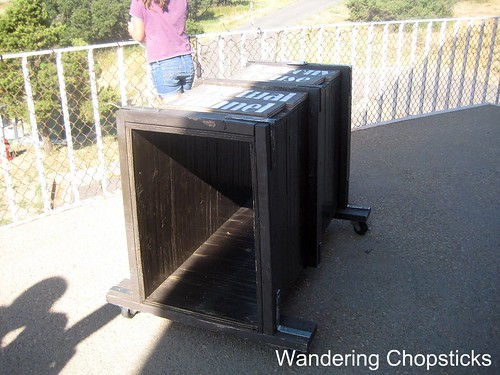
Here's the whole treacherous route down, through, and out of Balcony House. Remember, we're also at an elevation of 7,000 feet above sea level so it's already a little more difficult to breathe. The ladder on the right of the map was 32 feet high. The ladder steps on the left of the map were so narrow that I had to walk up sideways, while clinging to a chain link banister. The 12-foot tunnel was just before ascending the ladder steps.
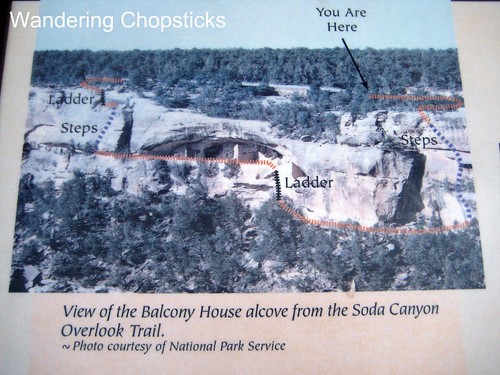
Of course, this route was for us tourists. The Anasazi had finger and toe holds on the side of the cliff and basically rock climbed to get in or out.
"Have you ever wondered what frightened the Anasazi so much that they withdrew to those isolated canyons?"
"Other men, what else? You don't go to all the trouble of building your towns halfway up the face of a sheer cliff, risking the life of every man, woman, and child as they climb up and down to tend the crops or draw water, for any animal less dangerous than man."
"In the end running and hiding didn't do the Anasazi any good. The ruins remain. The people are long gone." ("Fire and Rain, pg. 87)
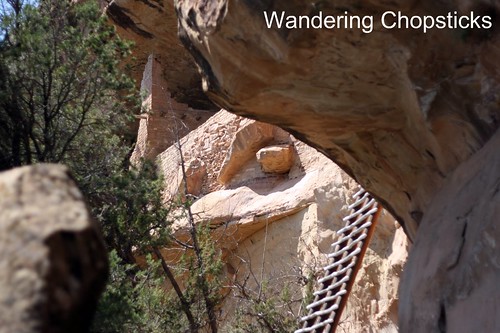
After a bit of background information from the park ranger, we ascended the 32-foot ladder. The sun was so hot that the wooden rungs felt like they were burning my hands as I climbed.
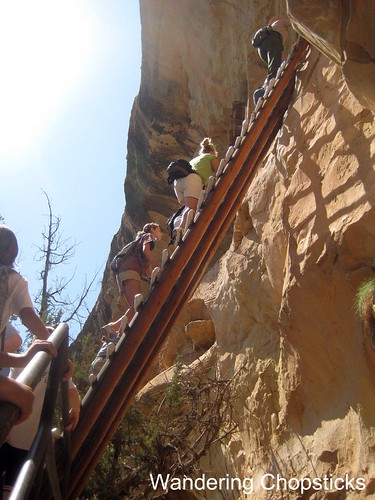
See the reason why this cliff dwelling was named Balcony House?
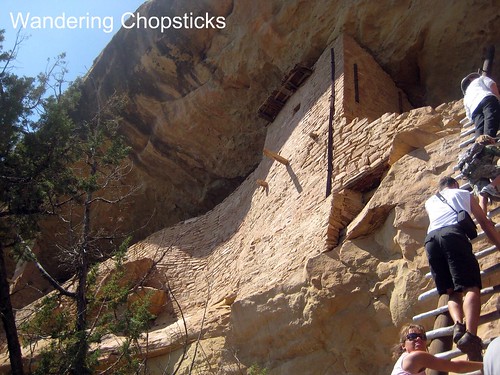
Phew!
Finally made it up.
Here's the look back down. That's Gourmet Pigs in the white baseball cap making her way up.
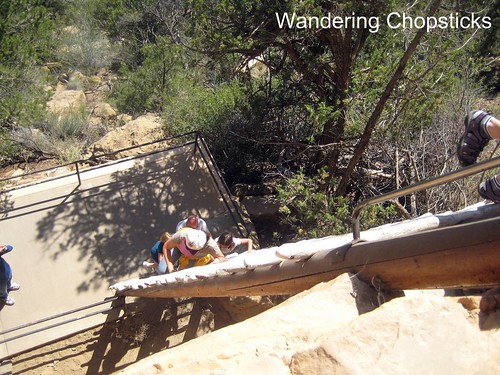
After the ascent, we entered a small alcove, sort of like an entry foyer, and had to climb through this little passage to get to the main part of Balcony House.
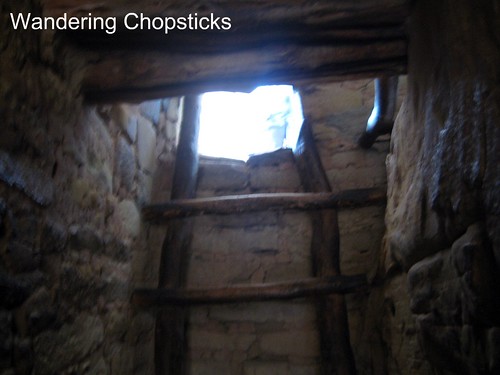
Only one tour goes through at a time. I forgot how many people each one is limited to.

A panoramic shot of the view from Balcony House.

The park ranger said they took samples of the wood and carbon dated them to the 1200s. I could even see holes underneath where they removed cores for the samples.
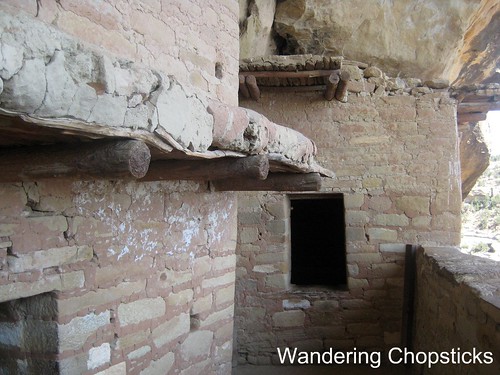
It's really hard to see how dry everything was and felt. One of the theories for why the Anasazi abandoned this area was a prolonged drought that lasted decades. Sandstone bricks and adobe mortar. I have no idea how they got enough water to even create that mortar.
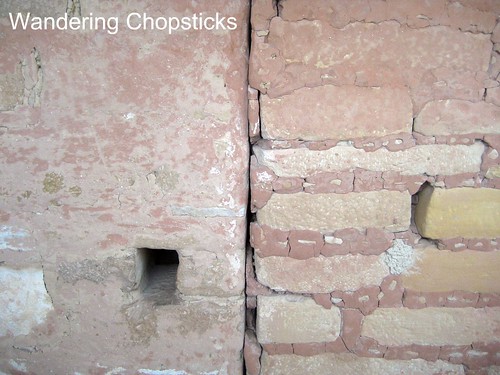
Notice the corner of the building because we'll be on the other side of it soon enough.
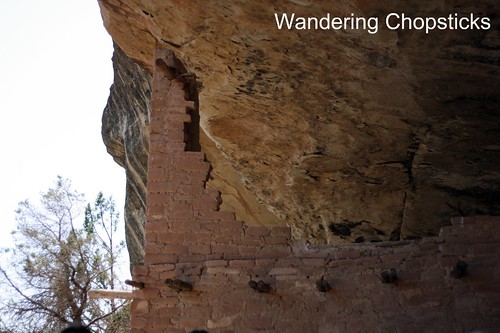
The Anasazi used various plant fibers to bind the mud.
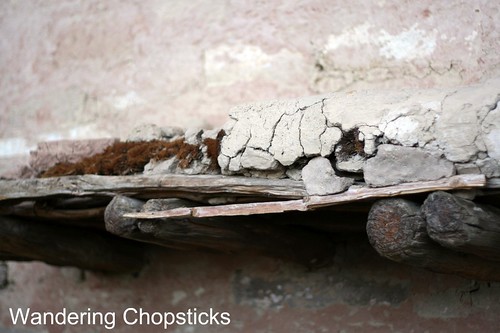
Time to go up this staircase to the other side.
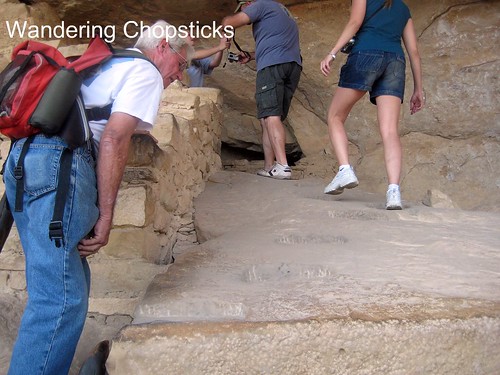
I wonder if the Anasazi had gouged the rock to make it easier, or whether the grooves were created by so many people stepping on the same place over hundreds of years?

At the top, we then had to go through this narrow passage.

Since the 40 rooms were built next to each other, and on the side of a cliff no less, it wasn't like they could create anything wider than a tight alleyway to go from one place to the next.
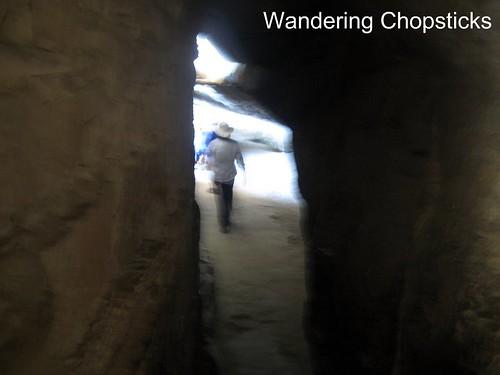
See? Now we're on the opposite side of the corner of the building.
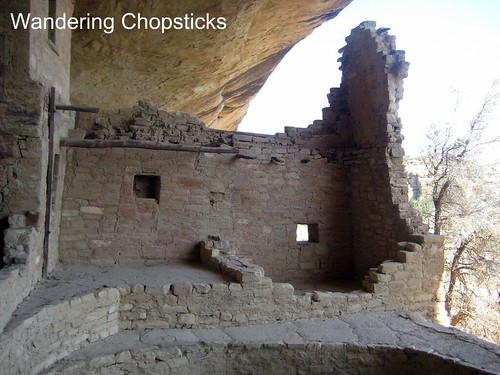
The pit below is a kiva, used for ceremonial purposes. The hole in the middle is a fire pit, the small shield was to prevent the air flow coming in from the other hole from putting the fire out. Back in its heyday, there would have been a flat roof over the kiva, and people would descend through a hole in the roof.
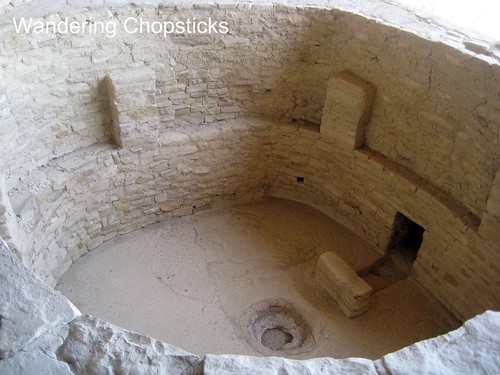
No guard rail here.
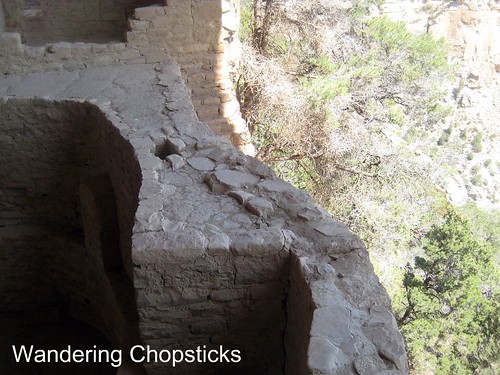
It's a steep drop down.
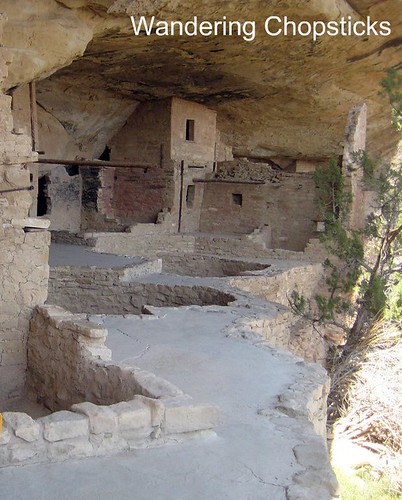
I can't believe so much of the cliff dwellings are intact after nearly a millennium later.
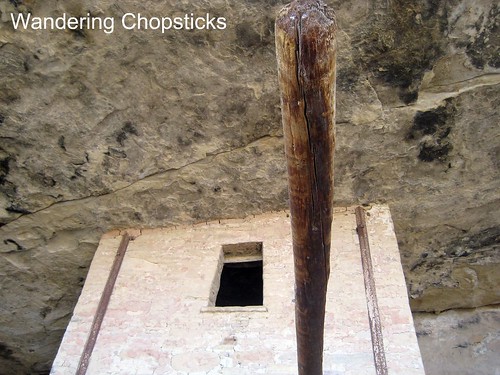
Hehe. The facade of this house looks like a face to me.

It was time to leave.
The tunnel we had to crawl through was actually inside this narrow passage.
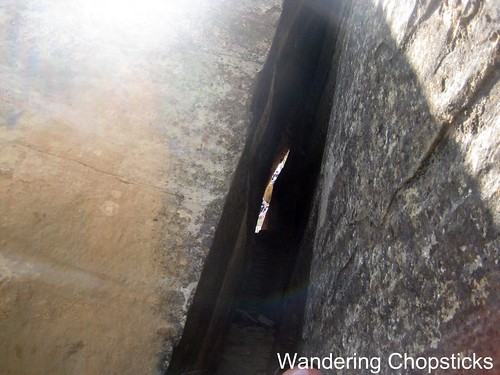
Crawling for 12 feet.
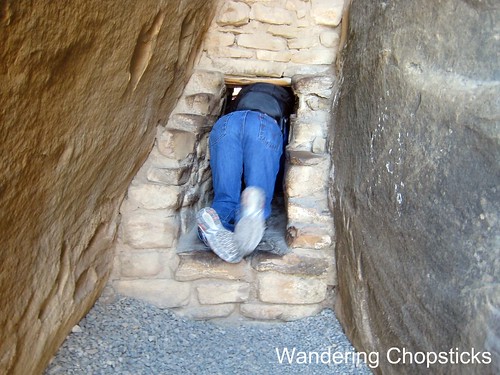
Then it was another ladder and those scary narrow steps. Someone brought their toddler and the little girl was freaking out. Poor thing.
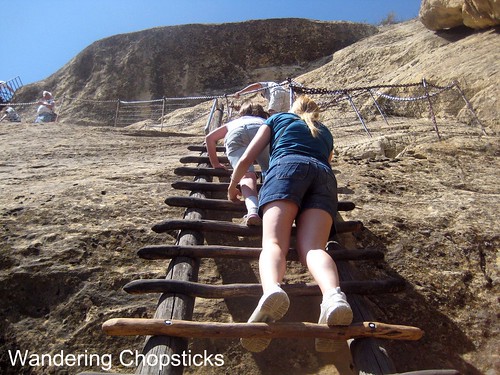
I told you those steps were narrow!
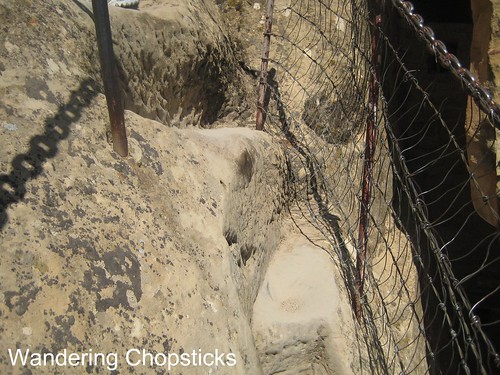
Time for me to ascend.
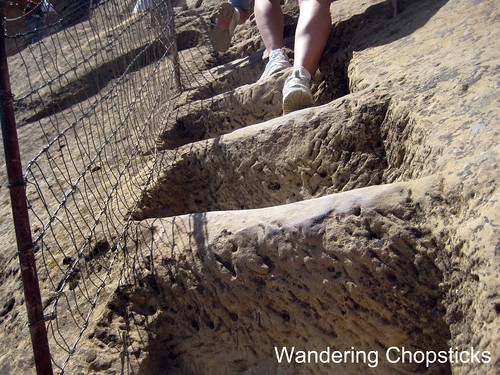
A look back at our route. See the square above the guy in the green hat? That was the 12-foot tunnel we crawled through before the ladder steps.
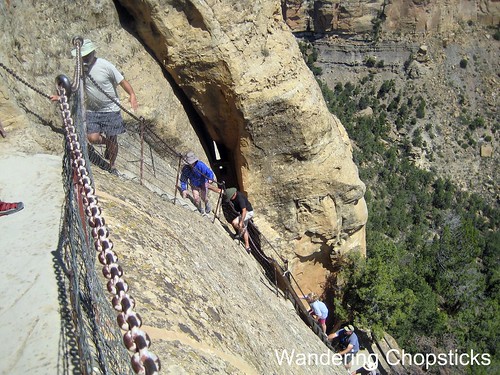
Man! That was quite a workout and pretty darn amazing. The final ascent was such a rush, climbing up a 60-foot cliff face of two 10-foot ladders and the narrowest steps ever.
But now, because of my overcautiousness, we had nearly an hour to kill before checking in at Cliff Palace.
Posts in this series:
Sadie's of New Mexico - Albuquerque - New Mexico
Anderson-Abruzzo Albuquerque International Balloon Museum - Albuquerque - New Mexico
Shiprock - New Mexico
Ted's Taco - Mancos - Colorado
Balcony House - Mesa Verde National Park - Colorado
House of Many Windows - Mesa Verde National Park - Colorado
Hemenway House - Mesa Verde National Park - Colorado
Cliff Palace - Mesa Verde National Park - Colorado
Spruce Tree Terrace Cafe - Mesa Verde National Park - Colorado
Chapin Mesa Archeological Museum - Mesa Verde National Park - Colorado
Spruce Tree House - Mesa Verde National Park - Colorado
Petroglyph Point Trail - Mesa Verde National Park - Colorado
Cortez Cultural Center - Cortez - Colorado
Main Street Brewery & Restaurant - Cortez - Colorado
Absolute Bakery & Cafe - Mancos - Colorado
Four Corners Monument - Shiprock - New Mexico
Pine Country Restaurant - Williams - Arizona
Grand Canyon National Park (South Rim) - Arizona
Mesa Verde National Park
P.O. Box 8
Mesa Verde, Colorado 81330
970-529-4465
7-day vehicle fee $10, $15 from Memorial Day to Labor Day
$3 tickets are required to take ranger-guided tours of Cliff Palace, Balcony House, and Long House. Tickets may be purchased from inside the park at Far View Visitor Center and must be purchased in person.
*****
1 year ago today, chile peppers and more tuong ot xa (Vietnamese lemongrass chile sauce).
2 years ago today, 2 of 7 random things about me meme: I buy my own flowers.
1.25

Wow! What an amazing tour! I've never heard of this place - it looks like something I'd like to try though (the more adventurous side of me). I know Bert and TC would probably like the challenge. Great photos! Gosh, just thinking of those narrow tunnels and those narrow ladder steps gives me the chills.
ReplyDeleteI love hiking, but I think I would be a total wimp during that hike. :P
ReplyDeleteCC,
ReplyDeleteIt's a really amazing place if you've never explored the Four Corners region before. Can you imagine going through the narrow tunnel and clinging to the side of the cliff every time you wanted to go in or out?
Diana,
Wait until you see the hike I did take to see cave paintings. It wasn't the 2.8 miles that was so bad, but the hiking down to the canyon floor and up to the top of the rim again at 7,000 feet elevation. My heart felt like it was going to pound out of my chest.